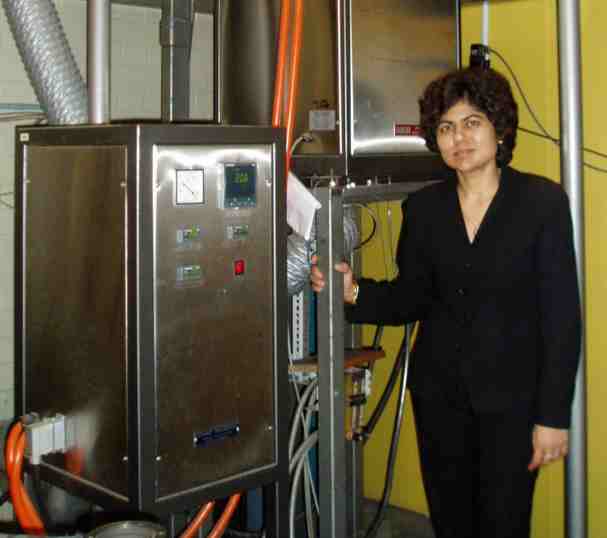The process of manufacturing environmentally friendly steel not only reduces coal use by one-third, it also salvages plastic waste from garbage dumps, cooking it at such intense temperatures that carbon emissions and energy consumption are cut dramatically. Developed in Australia, this breakthrough advancement of turning plastic waste into steel has now commenced commercial production at a Sydney steel plant. (Read more of this Good News Network North American exclusive…)
Six years ago, Indian-born Professor Veena Sahajwalla was staring into a steel-making furnace in Indianapolis when suddenly something clicked. What if she tried mixing waste plastic with the coal at intense temperatures? Could she invent new ‘green steel’?
 The science behind the question was elegantly simple. In electric arc furnace steelmaking, coal or coke is needed to trigger carbon reactions at intense temperatures. But carbon reactions, she theorized, could just as easily be generated using plastic that would otherwise be building up in landfills. Steel can’t tell where the carbon comes from so the end product would be identical.
The science behind the question was elegantly simple. In electric arc furnace steelmaking, coal or coke is needed to trigger carbon reactions at intense temperatures. But carbon reactions, she theorized, could just as easily be generated using plastic that would otherwise be building up in landfills. Steel can’t tell where the carbon comes from so the end product would be identical.
Today, Professor Sahajwalla is the Director of Sustainable Materials Processing at the University of New South Wales (UNSW) in Sydney and her green dream is about to become a commercial reality.
Australian steelmaker Onesteel has just obtained a worldwide license, in conjunction with UNSW’s commercial arm, NewSouth Innovations (NSi), for the manufacturing of plastic-injected low-emissions steel. Onesteel’s Sydney plant has already commenced production.
The new electric arc furnace process substitutes about 30 percent of coal and coke with polyethylene plastic waste; reducing pressure on garbage dumps. But, much more significant was the discovery that the plastic mix in creates a more efficient steelmaking process, promising to reduce emissions in one of the world’s dirtiest, but most essential, industrial processes.
After years of laboratory testing, Professor Sahajwalla discovered that her initial hunch during a sabbatical year spent in the United States, ‘up close, hot and dirty’ with the steelmaking industry, was correct. Carbon derived from plastic can be used in steelmaking, thus reducing the amount of coal inside a furnace. But, the realization that the plastic waste ‘mix in’ was actually more efficient than conventional electric arc furnace (EAF) steelmaking — which runs off large amounts of electricity — was an added bonus. Annually, the world produces about 1.1 billion tons of steel, about 40 percent of that in EAFs. Cutting electricity demand for industrial steel production represents major environmental and cost savings.
Social Benefits for Poor Societies
Beyond the environmental benefits, Professor Sahajwalla is looking forward to a social spin-off close to her heart. Born and raised in Bombay, India, she learnt very early that poor societies cannot afford waste. Everything is reused and recycled in India’s slums and poor rural communities, she says. The idea that polyethylene plastic — found in everything from shopping bags, to plastic packaging and plastic pipes — will become a valuable raw material for steelmaking could lift the economic prospects of the wretchedly poor, who live off picking over the third world’s rubbish dumps.
“The idea I find exciting is the possibility of up-cycling waste, giving it a higher value. In this process we have actually added value to waste. You have rubbish everywhere, this turns it into a whole new business venture.”
From a scientific point of view, the fact that carbon reactions are more efficient when plastic is added to the process is a compelling mystery which Professor Sahajwalla’s UNSW teams are still trying to unravel. It seems the plastic aids the “slag foaming” process and may improve furnace efficiency by sitting on top of molten steel like an insulating blanket.
“No one has looked at the uses of plastics at steelmaking temperatures of 1600 degrees C, and you can imagine the challenges of working with these temperatures in a lab are enormous. A lot of these reactions are being carried out for the first time,” she says.
The Big Aim: To Turn Trash into a Science
Her long-term goal is to develop ‘recycling science.’
“We have never really looked at waste with the respect it deserves. We shouldn’t look at rubbish as waste, but as just another resource and we need to develop the science to match.”
However, she is optimistic the momentum for environmental change is now unstoppable. “The environmental tide has turned," she says.
In the meantime, Onesteel has the right to sub-license the technology to more than 300 EAF steelmakers around the world. Onesteel has been testing the commercial viability of the process for two years and found the process reduces energy consumption at a rate of 11.1 kilowatt hours per charge ton.
Professor Sahajwalla’s own fascination for materials, and the industrial processes which produce them, began during her childhood in India. She was, she says, an “unusual girl” drawn to big machinery and furnaces. As an undergraduate in India, she was the only girl in her class, always bettering the grades of her male peers. As a post-graduate she went to Canada and the United States before being recruited by the CSIRO in Australia, and later by the University of New South Wales.
(Louise Williams is Associate Director of University of New South Wales International)
THANKS to Kay from Australia for submitting this story idea to the Good News Network!



















